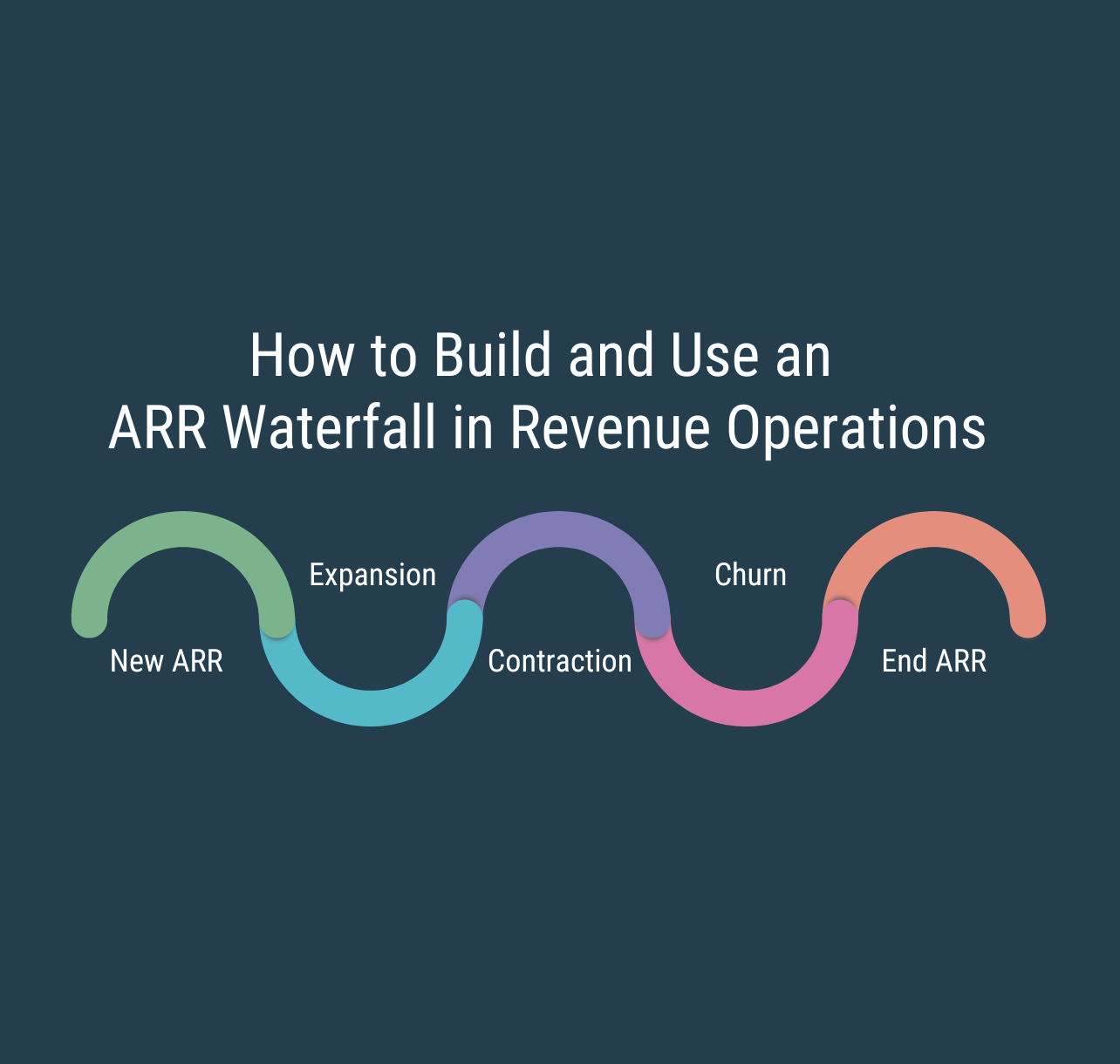ARR waterfalls are often seen as an output for finance to report to the board, but it’s an important tool for revenue operations teams as well. Here’s how to build and use an ARR waterfall to improve revenue operations.
What is an ARR Waterfall?
An ARR waterfall shows how your Annual Recurring Revenue (ARR) changes over time. It breaks down how much revenue you gained or lost and shows exactly where those changes came from.
If someone asks how your ARR went from $5 million to $7 million last quarter, the ARR waterfall explains it. It does not just show the new number. It shows how much came from new customers, upsells, and how much you lost to downgrades or churn.
Why Your RevOps Team Needs an ARR Waterfall
For RevOps teams, the ARR waterfall tells the full story of how your customer journey is translating to go-to-market performance. It is not just a finance tool. It helps you connect the dots between sales performance, customer retention, and expansion revenue.
Your leadership team probably asks questions like:
- Are we growing fast enough?
- Why did we miss our forecast?
- Where is our growth coming from?
- Are we keeping the right customers?
- Are existing customers spending more?
- How much revenue are we losing, and why?
The ARR waterfall helps you turn those questions into clear, data-backed answers. It also helps you spot warning signs before they become bigger problems.
How RevOps Teams Use ARR Waterfalls
The ARR waterfall is not just for board slides. It helps with day-to-day decision making and long-term revenue planning.
Some common use cases include:
- Forecast check-ins: see if monthly new ARR and expansion ARR are pacing with your plan. If not, your quarterly forecast may be at risk.
- Customer segmentation analysis: identify which industries, regions, or customer segments grow fastest and which ones are leaking revenue. A segmented ARR waterfall provides a consolidated picture of segment performance.
- Retention and expansion planning: track how much of your revenue comes from existing customers and see if customer success programs are working.
- Sales and marketing adjustments: if new logo ARR slows down but expansion ARR grows, it may be time to adjust outbound sales tactics or rethink pricing.
Revenue operations teams are missing a valuable tool if they don’t know how to build and use an ARR waterfall.
How to Build an ARR Waterfall
Every ARR waterfall tracks revenue changes across six key categories.
ARR waterfalls require multiple data sources for most businesses. Most companies pull ARR waterfall data from a mix of:
| Data | Common source | Context |
| Contracts | CRM / CPQ | Tracks contracted ARR, start dates, and renewal dates; used to calculate Starting ARR, New ARR, Expansion ARR, and Churn ARR (when customers terminate) |
| Product usage | Data warehouse, product analytics tools | For usage-based pricing models, product data is required to calculate Expansion ARR (as customers use more and move into higher tiers) and Contraction ARR (as usage drops) |
| Billing | Billing platforms (Stripe, Zuora, etc.) | Validates actual billed revenue, ensuring ARR adjustments are accurate; helps with New ARR, Expansion ARR, Contraction ARR, and Churn ARR |
| Customer segmentation | CRM, enrichment providers | Adds customer-level context (industry, size, geography), enabling segmentation of New ARR, Expansion ARR, Contraction ARR, and Churn ARR to see where revenue movement is concentrated |
| Customer success | CS platforms or CRM | Tracks health scores, renewal risk, and expansion opportunities; informs Expansion ARR, Contraction ARR, and Churn ARR projections |
| Pipeline | CRM | Shows deals closing soon that will contribute to New ARR in upcoming periods; helps forecast future ARR waterfall changes |
| Pricing / packaging | Price books in CRM | Ensures accurate classification of New ARR vs. Expansion ARR (especially for multi-product deals and upsells) |
Pro tip: The cleaner and more centralized your contract and billing data, the easier this is to calculate. Companies with scattered data across CRM, spreadsheets, and billing systems often struggle to get a reliable waterfall.
Common Pitfalls Your RevOps Team May Run Into
ARR waterfalls look simple, but they can get messy if your data is not clean. Some common pitfalls your RevOps team may run into include:
- Date mismatches: if your CRM, contracts, and billing systems use different dates, your ARR math will break.
- Mixing metrics: ARR tracks recurring revenue. Mixing in monthly recurring revenue (MRR) or total contract value (TCV) will confuse the analysis.
- New vs expansion confusion: if customers buy multiple products, you need clear rules to classify revenue. Otherwise, you will mislabel new deals as expansions, or vice versa.
- Timing issues: if sales marks a deal as won, but finance recognizes revenue later, your ARR waterfall will not match your financial reports.
- Spreadsheet errors: many companies still build ARR waterfalls in Excel, which introduces manual errors and inconsistent logic across teams.
How to Make Sure Your ARR Waterfall Drives Action
Your ARR waterfall should not sit in a static report. It works best when your RevOps team uses it as part of your regular operating rhythm. When you review it often, it becomes a powerful tool to help your sales, marketing, and customer success teams understand how revenue is moving and why. It provides leverage for RevOps to invest in aspects of the customer journey that are underperforming.
During monthly reviews, you can walk through the waterfall with your sales, marketing, and customer success leaders to show exactly how much revenue comes from new business, expansions, downgrades, and churn. These sessions provide a performance check for go-to-market initiatives. It indicates if your internal processes actually correlate to go-to-market success.
Your ARR waterfall also plays a key role in board meetings. Instead of just showing revenue numbers, you can use the waterfall to explain the story behind the numbers. It shows the balance between new customer growth and expansion from your existing customer base, along with any revenue you are losing to churn or contraction. The board is laser focused on this revenue build and it is vital that RevOps and finance get the data right.
Forecast check-ins are another place where your waterfall adds value. By comparing your actual new ARR, expansion ARR, contraction ARR, and churn ARR to your forecast, you can spot early signs that you may miss your targets. If you catch a shortfall early, you have time to adjust sales outreach, customer success outreach, or marketing campaigns before the end of the period.
Your team can also use the waterfall for segment analysis. Breaking down revenue movement by region, industry, product, or customer size helps you see where your go-to-market strategy works best. If a certain segment grows faster or churns more often, that insight can guide your ideal customer profile, account tiering, territory planning and messaging strategy.
Finally, the ARR waterfall helps you act quickly when problems pop up. If churn or contraction suddenly spikes mid-quarter, the waterfall makes it easy to spot. You can flag the issue right away and work with customer success to figure out the root cause before it gets worse.
By making the ARR waterfall part of your regular reviews and decision-making processes, you give every team a clearer picture of how the customer journey is performing and where you may need to shift your focus.
Automate ARR Waterfalls with AccountAim
Tired of combining data in an error-prone spreadsheet? Automate your ARR waterfall with AccountAim and get back to the strategic work that matters. Learn more here.








